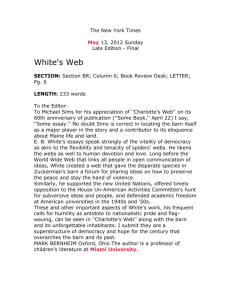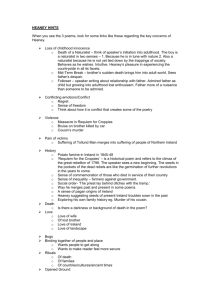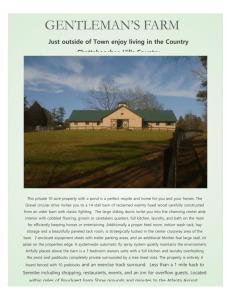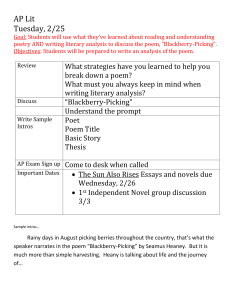The Barn
advertisement
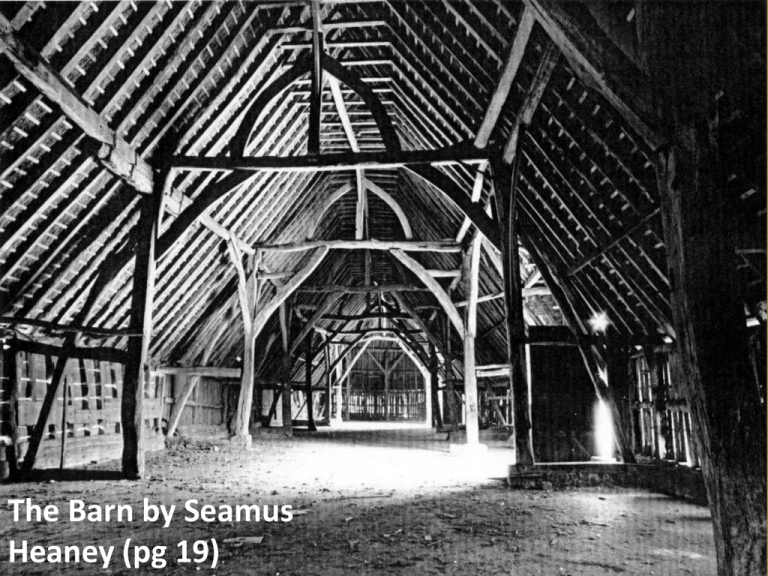
The Barn by Seamus Heaney (pg 19) The Barn This poem, like Death of a Naturalist, is a memory of the past. It is about Heaney’s experience of working in a barn when he was much younger. Heaney uses vivid similes and imagery to bring the barn to life. It has an almost supernatural feel and, by the end of the final stanza, a real sense of dread and danger. Subject and Themes • • • • • • Farm life Danger Fear Imagination Vulnerability Nightmares – childhood fears threshed – the corn has been harvested Threshed corn lay piled like grit of ivory Or solid as cement in two-lugged sacks. Opens with two similes – ‘grit of ivory’ suggests something valuable; ‘cement’ suggests heaviness ‘two-lugged’ – repeated at end – two handles like ears – bringing object to life musty – a stale or mouldy smell hoarded – the word means stashed away – suggests hidden trerasure is in the barn The musty dark hoarded an armoury Of farmyard implements, harness, plough-socks. list of three armoury – implies the barn’s contents of farmyard implements are war-like cold, uninviting imagery The floor was mouse-grey, smooth, chilly concrete. There were no windows, just two narrow shafts like a prison – the purpose of Heaney’s imagery is to make us experience the claustrophobia gilded motes – a mote is a speck of dust. Gilded means to have the quality of gold. You can visualise two narrow strips of dust through the slits in the barn walls highlighted in the sun from outside Of gilded motes, crossing, from air-holes slit High in each gable. The one door meant no draughts hot, uncomfortable gable – the triangular area at the top of the barn All summer when the zinc burned like an oven. A scythe's edge, a clean spade, a pitch-fork's prongs: list of three – maintains the steady rhythm of the poem sibilance - the ‘s’ sound in these words emphasises the potential for danger simile – the zinc is the metal that the tools were made of – you can imagine the heat in the barn ‘you’ – addresses the Slowly bright objects formed when you went in. reader directly Then you felt cobwebs clogging up your lungs – Heaney wants us to feel part of the alliteration on ‘c’ – emphasises a experience particularly unpleasant feeling of claustrophobia adverb ‘slowly’ drives the poem forward the verb ‘scuttled’ associates with the spiders – a need to escape And scuttled fast into the sunlit yard And into nights when bats were on the wing moves poem forward – a sense of restlessness Over the rafters of sleep, where bright eyes stared From piles of grain in corners, fierce, unblinking. ‘rafters of sleep’ – a metaphor – image of the barn follows the narrator into sleep nightmarish – it is only in the dark when the barn reveals its true menace. Choice of vocabulary shows how determined whatever lurks in the darkness really is The dark gulfed like a roof-space. I was chaff To be pecked up when birds shot through the air-slits. simile – emphasises the enormity of the darkness metaphor – chaff – inedible parts of the corn – the narrator is nothing better than feed for the birds tries to block out the horror he imagines I lay face-down to shun the fear above. The two-lugged sacks moved in like great blind rats. simile - poem ends with moment of real terror – continues the nightmare theme – like a horror film – the sacks are rats coming to get him Links with other poems… Most obviously links with ‘Death of a Naturalist’ as both poems deal with Heaney’s fear of nature and the ways in which the ordinary can become threatening or evil. The sacks of corn ‘move in like great blind rats’ just as the frogs become ‘great slime kings…gathered for vengeance’. We get the sense from all of Heaney’s poems in the anthology (except for ‘Mid-Term Break’, perhaps) that the childhood experiences of agriculture were not happy times for him or he was unable to fit in with them. Hints and Tips This is a reasonably easy poem to understand and has a number of key images and techniques that you can write about. Unfortunately, it does not link very easily with most of the other poems, although ‘Death of a Naturalist’ would certainly be a good one. You could also link it to the idea of memories which is also depicted in ‘Miracle on St. David’s Day’, ‘Follower’, ‘Digging’, “Mid-Term Break’, ‘At Grass’, ‘An Unknown Girl’ and ‘Once Upon A Time’. Example Questions 1. Look again at the poems ‘The Barn’ and ‘Death of a Naturalist’. What do these poems reveal about the imaginations of the childhood Heaney? 2. ‘The Barn’ is a poem about memory. Choose another poem from the anthology which also focuses on memory and compare the ways in which they are depicted.
